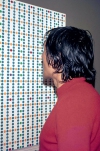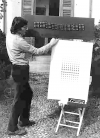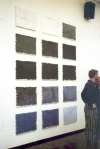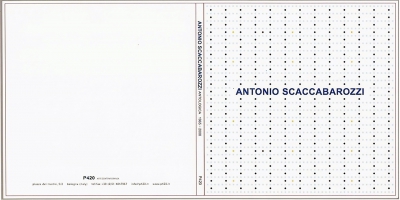The rare sound of silence
Notes on the work of Antonio Scaccabarozzi by Angela Madesani, october 2010
From the early Seventies the name Antonio Scaccabarozzi began to appear alongside some of the most important figures of the time. Umbro Apollonio, in the 1972 exhibition Incontro artistico ad Ardesio, exhibited his work alongside pieces by Alviani, Bonalumi, Castellani, Dorazio, Fontana and Nigro among others, just like in Faites votre jeu, held at the Cavallino Gallery in Venice1 the same year. At the Ubu Gallery in Karlsruhe his work was shown in a double solo exhibition with Dadamaino in 1973. There were many other occasions2. In 1973, in the magazine IBM3, Tommaso Trini published his works alongside those of Gianni Colombo, Jorrit Tornquist, Dadamaino and Sandro De Alexandris. In the 1976 Colore4 exhibition his work was shown together with that of Mario Ballocco, Mario Nigro, Piero Dorazio, Dadamaino and Rodolfo Aricò among others.
The time has come to re-read and re-evaluate in the right measure the work of this refined artist, who passed away in 2008, and maintained a distance from the glamour of the art world his whole life, except to see his lifelong friends: Gianni Colombo, Dadamaino, Rofolfo Aricò and other younger people. We find ourselves before a unique personality, a man who deeply loved his freedom and refused to compromise. Not due to a strange form of masochistic heroism, but rather for a genuine existential need. “I am isolated; I live here in touch with nature and do not inquire into commercial art and all that this entails. I only move when I am called to exhibit, and I take advantage of this to visit museums, to study artworks in person. As for the rest, despite knowing the context, I remain outside of this world and this is how I live, enjoying nature and my work: I could do more but I do not feel the need at all5”.
I do not think it out of place to mention here our first encounter. We were introduced in late 2001. Shortly afterwards I visited him in his studio, in Montevecchia, and I was fascinated by the way he approached making art.
At the beginning of 2002 I began to think of the exhibition Giorgio Morandi and the Morandiani6. Its theme was not a school of painting with Giorgio Morandi at its head, but rather a communion of attitudes towards the daily creating of art. Poetic choices certainly, but also, if not more so, poietic. I invited him to the exhibition and I was pleased: his was one of the pieces that most entered into the spirit of it, beyond banal choices of form or content. Then every so often over the years I would receive one of his catalogues, an essay, an invitation with which he always sent his regards. The memory of our acquaintance leads me to a pivotal moment of his being: that cleanliness, that purity essential to reach the ssence of things that has marked his research from the beginning.
Despite his cordiality Scaccabarozzi was a deeply severe man, with himself most of all: “It is not true that you can concede anything: if you begin to play with colours a landscape appears instantly, it might be beautiful, suggestive, but it is not art [...] Art, serious art, is something uncomfortable, that provokes thought and discussion [...]. The concept of beauty is not part of art because it diverts attention, creates confusion and does not cause refl ection. [...] I try to give the minimum so as to create maximum questions.”
We are here to retrace his entire journey, over forty years of work. From the mid Sixties until his death. In art his was a coherent journey that can be followed without major upheavals.
For the best part of his life he lived in a corner of Brianza which still exists, in Montevecchia. But this didn’t make him a solitary monk, shut up in his hermitage. On the contrary Scaccabarozzi travelled, observed with profound curiosity, striving to understand, to know. A strong, intense relationship always bound him to Milan, the city where he spent his formative years in the Fifties, while he was an apprentice in a typolithography workshop. Those years were a fantastic time to be in the city, with avant-garde galleries, Spazialismo, Manzoni, Fontana and many Others.
In 1957 he decided, together with friend and classmate Anchise Roncato, to go to Paris. A sort of training trip. To make ends meet in the French capital they began to work in the theatre, helping build the large scenery. There they met other important figures from that scene: Pierpaolo Pasolini, Maria Callas, Franco Zeffirelli and Luchino Visconti from afar. An interesting, fascinating world, but Scaccabarozzi was determined to be an artist and decided to return to Italy and settle in his hometown Merate, relatively close to Milan, from where it was easy to move when he felt like it. In catalogues of his works published when he was still alive, he himself decided to begin his journey in the art world in the late Sixties.
In this period, between 1965 and 1970 to be precise, he created a series of non-fi gurative works in which the memory of certain geometric abstraction can be retraced. They were clean works, in which the themes under investigation were space, but also the different textures of the material. In 1969 he created an environmental artwork for the Adlers, at Santa Margherita Ligure: Rotazione continua. In those years he also became acquainted with an important Italian art scene, Antonio Calderara7, whose work was very popular abroad, especially in Germany. The artist, then over sixty, liked to take talented young people under his wing and the young Antonio was among them. Moreover, as mentioned above, Scaccabarozzi had begun to frequent some of the most interesting Italian artists of that period, in particular Dadamaino and Gianni Colombo, who would later introduce him to La Cappelletta di Osnago8, protagonist of an intense season of exhibitions during the Seventies.
It was a historic period during which many artists were questioning the sense of what they were doing. Scaccabarozzi worked mainly on method, which gives, according to his reading, the best results in its overcoming. In that sense the thinking of Rosalind Krauss comes to mind, who in some of her essays dealt with this reflection in reference to the overcoming of the medium: think Jackson Pollock.
With his Strutturali works, dated 1969-1979, Scaccabarozzi leans towards a sort of degree zero. This leads to the emblematic abolition of the brush to workt fi gure on the with hammer and punch alone on white painted canvas. His was a sort of ritual operation, a precise, methodical, and at the same time strongly spiritual attention to his daily work, his total artistic being. All this to get to the heart of phenomena, the essence of things, without compromise or ambiguity.
Prevalenze are also from these years, of which Luciano Caramel9 wrote in 1975, having been asked many questions about the prevailing element in this work: “The result is a stimulating ambiguity of situations, accentuated by the placing of the entire operation around minimal thresholds of perception, which renders the process of deciphering the images and their versatility far from easy, in singular contrast – here lies another non secondary source of interest – to the apparently reassuring obviousness seen at first glance, which contributes to the stringency of the structural distribution, exactly calculated, as is immediately noticeable.” Faced with Scaccabarozzi’s works we do not fi nd ourselves before a creation of modules, repeated in static fashion, but rather, to paraphrase Deleuze, this is precisely the diff erence that subverts repetition: it is a question of minimals. It is interesting to consider this initial moment in his work a reflection on space – if you think of the installations10 in that sense - time and the relationship created between them.
One of his little known, but very important works is from the late Seventies: Misura reale- misura rappresentata. It is one of the rare occasions in which he uses photography. Many artists were using it in that period and still, it is interesting to note with how much intelligence Scaccabarozzi makes use of that medium, as if to provide further proof of something he had already attested for years with what could be called his pictorial research. It is a sort of trail, recording, in line with certain Land Art style works,〈...........〉, seeking to investigate the relationship between reality and its representation. The artist’s book of the same year Misura/Distanza11: centre of reflection was a measurement of Giulio Carlo Argan’s L’Arte Moderna 1770/1970, edited by Sansoni, where whole generations had their fi rst complex relationship with the history of art. He measures it in all its parts to emphasise its thickness, which at that juncture the artist considered distance. Scaccabarozzi measured the volume because it was the container of experience that should be read in order to reach understanding. Here space becomes space of knowledge, of learning, a method by which to possess things.
To return to Strutturali, in these works Scaccabarozzi analysed the structure of the dot which, he used to say, reminded him of the back of the hammer belonging to his cobbler Grandfather, with whom he spent the fi rst years of his childhood.
From here, from his analysis of the structure of the dot, he achieved creation of the module. In the early Eighties measurements lost their structural coherence and became something else. We fi nd ourselves here before an experimenter, aiming to try many paths so as to be able to grasp the sense of things. He immerses the canvas in colour or injects it with syringes. In other works he places colour on the canvas having weighed it with the precision of an instrument normally used by goldsmiths, or he writes on the canvas with a brush dipped in more or less dense colour.
We face a Scaccabarozzi with an ironic attitude towards the profession of painting. His is a subtle, intelligent irony, a sort of common theme that runs through the course of his artistic journey. During this reserved and precise artist’s over forty years of activity, one perceives a lightness of Calvino12 origin. Lightness dense with meaning that characterised his life as an artist and a man. To briefl y explain the series of works on which he worked between 1983 and 1994, Quantità, Scaccabarozzi wrote, “Works characterised by the idea that spreading an amount of colour is already painting.” Once more we see a veiled irony in him. As if the artist wanted to put things back in their place and reassign them their proper value. They are works that to some extent have a tautological value, that try to analyse the sense, the meaning of a certain action. The colours used are of an industrial nature, subject to wear, there is no pretence of preciousness but rather a declaration of normality. The artist is a contemporary animal, a child of his time. There is no lyricism of the material, the poetry lies in the simplicity, the very force of the choice itself, inconvenient most of the time. The colour,
but fundamentally the painting, is a need for different moments that, from time to time, are influenced by the situations in which the artist finds himself. He wrote, “All colours possess diff erent and unique potential, which often remains unknown until somebody grasps that importance and somehow makes it visible.”13
As I study his work, Verifi che by Ugo Mulas comes to mind, an investigation that took place in the final years of the photographer’s brief life and that explores the sense itself of the medium. In this way Scaccabarozzi investigated over time, with the attitude of a conceptual artist, the sense of painting, colour and the spatial and formal relationships between things.
With Barriere in 1995 the work became an object that separates and contains space. In 2000 he wrote, “The idea is to place the work as the frontier-zone between opposing forces. Where the tension that is established between the confi guration of the object and the gaze that goes beyond it carries that idea of vitality.” From here began the use of polyethylene, a poor material, deprived of any artistic memory, which from 1996 would be his main working material for almost ten years. Thus the work becomes an essential simplicity, consisting of a single medium, this thin plastic in different colours. It seems to me that this is the work that most connotes him, a sort of readymade painting, which makes the artist instantly recognisable. Polyethylene is a contemporary material that Scaccabarozzi used in a completely original way, with a spirit that certainly owes more to Duchamp than to traditional painting.
Almost ten years later, in 2007, Stephan Berg wrote14, “With a great and extensive piece created in 1998, Scaccabarozzi gave a valid formulation to this confused and fertile interconnection. The piece consists of a portion of transparent polyethylene, 5 metres long by 1 metre tall, cut into a grid to shut out the space that unfolds behind it, denying it access. As a permeable membrane polyethylene activates the space and transforms it contemporaneously into an image of itself, insofar as the work is positioned as a barrier between the space and the spectator. The work, in turn, transforms the inconsistency of its material into an imposing proposal, voluminous and sculptural but simultaneously insisting on its ephemeral nature. The structure cut into the sheet offers the possibility of reading the work both as representative and self-referential: as a grid, a fence, a sequence of elementary geometric forms or as a sequence of empty and framed pictorial squares. As such, he thematises the essential prerequisite for the very existence of the work, in other words, its delimitation, the frame, that describes the work itself as a void.”
Faced with works of this nature, his interest in the aesthetic value of the void is clear, which then assumes a philosophical value of Zen origin. A void of reflection that, from time to time, becomes shadow and absence and contrasts with the fullness of the material – the medium that the work is made of.
From time to time the polyethylene forms are at the same time object of the gaze’s concentration and its obstacle, filter through which we see our surroundings. The material and the shadow created by it assume equal importance. On the occasion of the exhibition previously mentioned I wrote, “They are works of apparent delicacy, but in reality they are extremely strong materially: they can be folded, handled, put in your pocket. Scaccabarozzi handled them with scant delicacy; he detaches them and reattaches them without care. He is harsh with them and dismisses them each time with a simple fold.” In that sense he strips his art of its aura. At this point his research becomes especially difficult, tricky to digest for a market that believes it is buying immortality. They are delicate sheets, easily ruined, that can be torn, a cat might scratch them, as happened in a Swiss gallery, but this is precisely why they are extremely precious. In these works, which at certain moments bear the name of the place (2000) where the material was bought as a title, lies the sense of a brave investigation, complex, light and difficult at the same time. The chromatic differences are occasional therefore. Scaccabarozzi worked over the years without worrying about the simple pleasure of things. His is a pure, candid, profoundly spiritual attitude. The artist stands naked before the world, to express all his possible truth. In the late Nineties his works, “whilst maintaining their characteristics, have developed formally and are now suspended in space, astride a nylon thread stretched between two nails. The idea is to place the work as the frontier-zone between opposing forces. Where the tension that is established between the configuration of the object and the gaze that goes beyond it carries that idea of vitality.” 15
The series entitled Eclissi began in 2002. To explain them the artist wrote, “They are works composed of two chromatic bodies fixed a short distance apart one overlapping the other. As one’s point of view moves with respect to the art work, so does the overlapping surface, until it completely covers the other. The preceding sensory field undergoes a sudden and radical change.” From the following year he worked on Banchise (2003-2004), with reference to the great masses of ice in the north. It was, “a cycle of works that enhanced the measurement in depth, between a visible reality and a more hidden one,” an investigation into the complexity of the gaze. A study, of a philosophical nature, into the impossibility of arriving at the truth of things and the relativity of these same. Turning to gaze at the ordered books, left by the artist in the bookshelves of his studio home, one notices a conspicuous presence of Nietzschean literature, author, beloved philosopher, who read the history of western culture as the history of nihilism. A vision that the artist felt was particularly close to his way of viewing his surroundings.
Throughout his life Scaccabarozzi experienced a continual need for depth, to go beyond the mere appearance of phenomena, continually applying himself to grasp the sense of things. For this reason the works he has left us are not so much answers as questions about making. Questions that became more insistent, though delicate, calm, in the final years of his life, when he realised that the world around him was turning in a direction more different than he could have imagined. All the more reason to feel protected far away from an audience, events, scandal. His work is the countertrend to what is requested by the official art system. Countertrend, but perhaps that is precisely why it is more transgressive, able to whisper with conviction of purpose all the force it is imbued with.
At the time of his tragic death, in a minor road accident a few kilometres from his house in 2008, Antonio Scaccabarozzi had been working for some years on Velature. Works with which he was once more investigating language, but above all the craft of painting. Canvases painted with a single colour upon which equal transparent layers are applied with the rush in a sort of ritualistic action, a different number of layers every time. “The work constantly develops between the colour of the background and that of the layer chosen for the occasion, if the applications increase the colour of the background becomes more distant and the painting becomes more and more the colour of the layer.
At a certain point during the process, if all goes well, a particular emotional state occurs to indicate accomplishment; a clear feeling of having reached the sense of the union of these two colours, which merge into a new unity through the validity of the process. This result is sometimes obtained after a single layer.”16 The colour is covered by many vertical layers of another colour, not for nothing is the series entitled Velature (Layers).
In 2007 Stephan Berg wrote to this regard, “The base colour influences the number of applications just as these alter the base layer of colour, for example, covering it almost entirely, or allowing it to mostly show through. In any case, the artist is always seeking that precise point at which the beginning and the end of a work come together in balance. To this regard, it should be noted that Scaccabarozzi, during his studies on the pure experience of colour, not once allowed himself to be led or influenced by the prevailing trend or yield to an emotional and colouristic romance. For him the question remains of how to connect colour, as experience that has reached its intrinsic nature, and the contradictory character of reality, whilst preventing colour from assuming illustrative or imitative qualities. It is always a question of zones of friction in which ones own individual measure meets another unfamiliar one which unleashes a creative flare.” It is a reference to the old masters, to the great tradition of painting, to Georges de la Tour, among his favourites, to Venetian masters of colouristic painting. Tradition and antiquity are constant reference points along his path. In the Nineties he himself wrote that he had been deeply moved before the temple of Hephaestus, when, somehow he found himself turning around the columns and noticed that they allow a glimpse of the inner wall and from certain angles they close it in completely, so as to create a sort of visual ambiguity, which we also find in some of his works.
In his works we find the poetry of the small things, the power to make us pause before the frenzy of our surroundings, in a state of grace before nature, to grasp the sense of a dot or a particular colour, whether it is blue or Naples yellow. At a closer look you perceive his working method, formal cleanliness and more, the daily self-discipline facing art which leads, those observing his works as well, to the perception of the rare sound of silence.
1 An exhibition curated by Ernesto L.Francalanci. Among the invited artists: Alviani, Bonalumi, Boriani, Colombo, Dadamaino, Nannucci,Tagliaferro, Uecker, Vaccari, Vostell.
2 Only some of the exhibitions that Antonio Scaccabarozzi took part in are indicated here: Der rahmen, meine welt - italienischen tischlers at Neue Galerie am Landesmuseum Joanneum und Kunstlerhaus di Graz (1978), curated by Wilfried Skreiner, exhibited alongside, among others, Bonalumi, Calderara, Castellani, Colombo, Dadamaino, Fontana, Manzoni. In 1977 he exhibits at Rationale konzept 77, curated by Michel Seuphor at Stadtische unstsammlung, Gelsenkirchen- Buer with, among others, Albers, Bill, Colombo, Varisco, Vasarely. In 1986 he exhibits at The corner at the Hoff mann Gallery in Friedberg, with, among others, Alviani, Colombo, Morellet, Nannucci, and Tornquist. In 1990 he exhibits at Stadtische Gallery in Ludenscheid in the exhibition Temporale con Colombo, Blank, Nanni Valentini, Helmut Dirnaichner. In 1992 he exhibits at Only paper? at Stadtische Gallery Villa Zanders, di Bergisch Gladbach with, among others, Kolar, Cage, Chillida, Christo, Girke, Noland, Rotella, Uecker, Villeglè, Vostell.
3 T.Trini, Arte concreta e altri rami dell’albero astratto in Rivista IBM Periodico trimestrale della IBM Italia, Volume IX edition 4/1973, p. 16 onward.
4 Colore Silvestro Lega prize 1976 curated by U.Apollonio, L.Caramel, M.Fagiolo, Modigliana-Forlì 31 July- 26 September 1976.
5 Conversation between Lorenza Pagano and Antonio Scaccabarozzi, Il minimo per creare il massimo, in Giornale di Lecco, 10 September 1990; p.3.
6 Exhibition held at the Cascina Roma Contemporary Art Gallery at San Donato Milanese from 18 May – 23 June 2002.
7 Antonio Calderara was also one of the artists present in the previously mentioned exhibition dedicated to Morandi.
8 The Casati family gallery, as prestigious as it is forgotten, in Osnago, between Milan and Lecco.
9 L.Caramel, Centro RS, Como, 1975
10 Among them the installation held in 1979 at the Ferrari Gall., Verona
11 E.L.Francalanci writes in 1979, regarding the book: «It gathers some of the premises of the “Obviousness of poetic-measurements of distance” programme», premises that address the aspects and considerations of the concept of measurement. The volume is composed of photographs glued onto Bristol board, some original drawings and illustrative texts.
12 The reference is to the lightness which Italo Calvino discusses in American Lessons.
13 A.Scaccabarozzi, Giallo di Napoli, 2007.
14 S.Berg, Il peso di un’immagine, text from the catalogue for the exhibition held at Galerie Katharina Krohn, Basel, 2007.
15 A.Scaccabarozzi, Lo sguardo attraverso, Athens, July 1995 - Montevecchia, 2000.
16 A. Scaccabarozzi, Velature, 2005.







